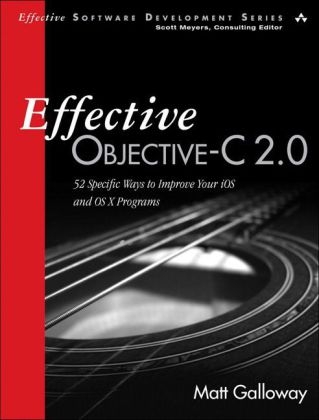
Effective Objective-C 2.0
Addison-Wesley Educational Publishers Inc (Verlag)
978-0-321-91701-0 (ISBN)
- Titel ist leider vergriffen;
keine Neuauflage - Artikel merken
Effective Objective-C 2.0 will help you harness all of Objective-C’s expressive power to write OS X or iOS code that works superbly well in production environments. Using the concise, scenario-driven style pioneered in Scott Meyers’ best-selling Effective C++, Matt Galloway brings together 52 Objective-C best practices, tips, shortcuts, and realistic code examples that are available nowhere else.
Through real-world examples, Galloway uncovers little-known Objective-C quirks, pitfalls, and intricacies that powerfully impact code behavior and performance. You’ll learn how to choose the most efficient and effective way to accomplish key tasks when multiple options exist, and how to write code that’s easier to understand, maintain, and improve. Galloway goes far beyond the core language, helping you integrate and leverage key Foundation framework classes and modern system libraries, such as Grand Central Dispatch.
Coverage includes
Optimizing interactions and relationships between Objective-C objects
Mastering interface and API design: writing classes that feel “right at home”
Using protocols and categories to write maintainable, bug-resistant code
Avoiding memory leaks that can still occur even with Automatic Reference Counting (ARC)
Writing modular, powerful code with Blocks and Grand Central Dispatch
Leveraging differences between Objective-C protocols and multiple inheritance in other languages
Improving code by more effectively using arrays, dictionaries, and sets
Uncovering surprising power in the Cocoa and Cocoa Touch frameworks
Matt Galloway is a software engineer and programming enthusiast specializing in mobile app development. He studied engineering at the University of Cambridge, England, and graduated in 2007 specializing in electrical and information sciences. He owns a consultancy, Swipe Stack Ltd., and answers questions about Objective-C, iOS, and Mac programming on Stack Overflow (stackoverflow.com).
Preface xi Acknowledgments xv
About the Author xvii
Chapter 1: Accustoming Yourself to Objective-C 1
Item 1: Familiarize Yourself with Objective-C’s Roots 1
Item 2: Minimize Importing Headers in Headers 4
Item 3: Prefer Literal Syntax over the Equivalent Methods 8
Item 4: Prefer Typed Constants to Preprocessor #define 12
Item 5: Use Enumerations for States, Options, and Status Codes 17
Chapter 2: Objects, Messaging, and the Runtime 25
Item 6: Understand Properties 25
Item 7: Access Instance Variables Primarily Directly When Accessing Them Internally 33
Item 8: Understand Object Equality 36
Item 9: Use the Class Cluster Pattern to Hide Implementation Detail 42
Item 10: Use Associated Objects to Attach Custom Data to Existing Classes 47
Item 11: Understand the Role of objc_msgSend 50
Item 12: Understand Message Forwarding 54
Item 13: Consider Method Swizzling to Debug Opaque Methods 62
Item 14: Understand What a Class Object Is 66
Chapter 3: Interface and API Design 73
Item 15: Use Prefix Names to Avoid Namespace Clashes 73
Item 16: Have a Designated Initializer 78
Item 17: Implement the description Method 84
Item 18: Prefer Immutable Objects 89
Item 19: Use Clear and Consistent Naming 95
Item 20: Prefix Private Method Names 102
Item 21: Understand the Objective-C Error Model 104
Item 22: Understand the NSCopying Protocol 109
Chapter 4: Protocols and Categories 115
Item 23: Use Delegate and Data Source Protocols for Interobject Communication 115
Item 24: Use Categories to Break Class Implementations into Manageable Segments 123
Item 25: Always Prefix Category Names on Third-Party Classes 127
Item 26: Avoid Properties in Categories 130
Item 27: Use the Class-Continuation Category to Hide Implementation Detail 133
Item 28: Use a Protocol to Provide Anonymous Objects 140
Chapter 5: Memory Management 145
Item 29: Understand Reference Counting 145
Item 30: Use ARC to Make Reference Counting Easier 153
Item 31: Release References and Clean Up Observation State Only in dealloc 162
Item 32: Beware of Memory Management with Exception-Safe Code 165
Item 33: Use Weak References to Avoid Retain Cycles 168
Item 34: Use Autorelease Pool Blocks to Reduce High-Memory Waterline 173
Item 35: Use Zombies to Help Debug Memory-Management Problems 177
Item 36: Avoid Using retainCount 183
Chapter 6: Blocks and Grand Central Dispatch 187
Item 37: Understand Blocks 188
Item 38: Create typedefs for Common Block Types 194
Item 39: Use Handler Blocks to Reduce Code Separation 197
Item 40: Avoid Retain Cycles Introduced by Blocks Referencing the Object Owning Them 203
Item 41: Prefer Dispatch Queues to Locks for Synchronization 208
Item 42: Prefer GCD to performSelector and Friends 213
Item 43: Know When to Use GCD and When to Use Operation Queues 217
Item 44: Use Dispatch Groups to Take Advantage of Platform Scaling 220
Item 45: Use dispatch_once for Thread-Safe Single-Time Code Execution 225
Item 46: Avoid dispatch_get_current_queue 226
Chapter 7: The System Frameworks 233
Item 47: Familiarize Yourself with the System Frameworks 233
Item 48: Prefer Block Enumeration to for Loops 236
Item 49: Use Toll-Free Bridging for Collections with Custom Memory-Management Semantics 243
Item 50: Use NSCache Instead of NSDictionary for Caches 248
Item 51: Keep initialize and load Implementations Lean 252
Item 52: Remember that NSTimer Retains Its Target 258
Index 265
| Erscheint lt. Verlag | 30.5.2013 |
|---|---|
| Verlagsort | New Jersey |
| Sprache | englisch |
| Maße | 178 x 230 mm |
| Gewicht | 604 g |
| Themenwelt | Informatik ► Betriebssysteme / Server ► Macintosh / Mac OS X |
| Informatik ► Programmiersprachen / -werkzeuge ► Mac / Cocoa Programmierung | |
| Technik ► Nachrichtentechnik | |
| ISBN-10 | 0-321-91701-4 / 0321917014 |
| ISBN-13 | 978-0-321-91701-0 / 9780321917010 |
| Zustand | Neuware |
| Haben Sie eine Frage zum Produkt? |
aus dem Bereich


